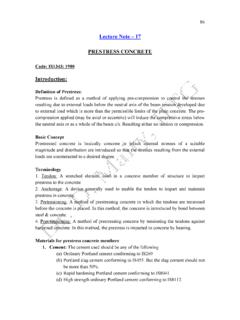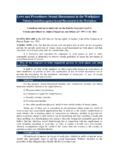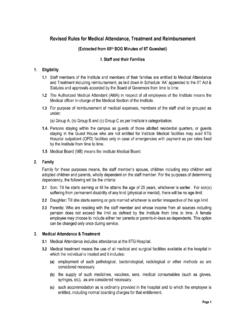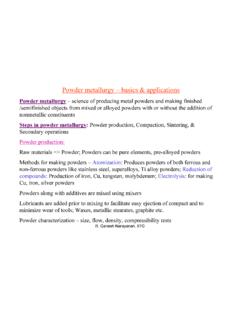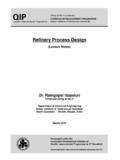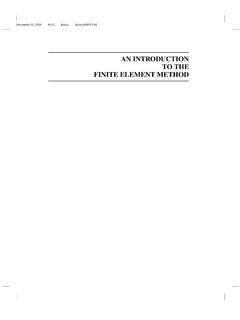Transcription of FINITE ELEMENT METHOD: AN INTRODUCTION - iitg.ac.in
1 1 FINITE ELEMENT METHOD: AN INTRODUCTION Uday S. Dixit Department of Mechanical Engineering, Indian Institute of Technology Guwahati-781 039, India 1. INTRODUCTION FINITE ELEMENT method (FEM) is a numerical method for solving a differential or integral equation. It has been applied to a number of physical problems, where the governing differential equations are available. The method essentially consists of assuming the piecewise continuous function for the solution and obtaining the parameters of the functions in a manner that reduces the error in the solution. In this article, a brief INTRODUCTION to FINITE ELEMENT method is provided. The method is illustrated with the help of the plane stress and plane strain formulation. 2. FEM formulation for a linear differential equation A linear differential equation can be of the following form: L + 0u q = , (1) where u is the vector of primary variables of the problem, which are functions of the coordinates, L is the differential operator and q is the vector of known functions.
2 This differential equation will be subjected to boundary conditions, which are usually of two types- (i) the essential boundary conditions (ii) the natural boundary conditions. The essential boundary conditions are the set of boundary conditions that are sufficient for solving the differential equations completely. The natural boundary conditions are the boundary conditions involving higher order derivative terms and are not sufficient for solving the differential equation completely, requiring atleast one essential boundary condition. For example, consider the differential equation: d d0d d + = uEA qx x . (2) This problem can be solved completely under one of the following two conditions: (i) u is prescribed at both ends. (ii) u is prescribed at one end and du/dx is prescribed at the same or other end.
3 However, the problem cannot be solved if only du/dx is prescribed at both ends. Thus, we surely require one boundary condition prescribing u. Therefore, for this problem u= u* is an essential boundary condition and du/dx= (du/dx)* is a natural boundary condition, where * indicates the prescribed value. Now consider the differential equation 2222d d0ddwEIqxx = , (3) This differential equation can be solved completely by specifying w and dw/dx at both ends. One can also specify d2w/dx2 and/or d3w/dx3 as boundary conditions, however out of total four boundary conditions, two must be of one of the following forms: (i) w prescribed at both ends. (ii) w prescribed at one end and dw/dx prescribed at the other end. Thus, the prescribed values of w and dw/dx form the part of essential boundary conditions and prescribed values of d2w/dx2 and d3w/dx3 form the part of natural boundary conditions.
4 Two popular FEM formulations are Galerkin formulation and Ritz formulation. In Galerkin formulation, the primary variable is approximated by a continuous function inside the ELEMENT . When the approximate primary variable ue is substituted in Eq. (1), we shall get residue depending on the approximating function, , L + eu q = R . (4) 2 Ideally, the residue should be zero everywhere. In that case, approximation becomes equal to true value. As it is very difficult to make the residue 0 at all points, we make the weighted residual equal to zero, , d 0DA= wR , (5) where w is the weight function. In order to weaken the requirement on the differentiability of the approximating function, we integrate Eq. (5) by parts to redistribute the order of derivative in w and R.
5 In Galerkin method, the weight function is chosen of the same form as the approximating function. The approximating function is some algebraic function. It is common to replace the unknown coefficients of the function by unknown nodal degrees of freedom. Thus, typically, {}[ ]N=eneuu . (6) where [N] is the matrix of shape functions and {une} is the nodal degrees of freedom. In Ritz formulation, the differential equation Eq. (1) is converted into an integral form using calculus of variation. (Sometimes the integral form itself may be easily derivable from the physics of the problem.) The approximation (Eq. (6)) is substituted in the integral form and the form is extremized by partially differentiating with respect to {une}. After obtaining the elemental equations, the assembly is performed.
6 A simple way of assembly is to write equations for each ELEMENT in global form and then add each similar equations of all the elements , , we add the equation number 1 from each ELEMENT to obtain the first global equation, all equation number 2 are added together to give second equation, and so on. The boundary conditions are applied to assembled equation and then are solved by a suitable solver. Then, post-processing is carried out to obtain the derivatives. 3. Formulation for plane stress and plane strain Consider a linear elastic solid of domain and having uniform thickness bounded by two parallel planes on any closed boundary as shown in Fig. 1. The meaning of boundary conditions is explained in Figure 2. If the thickness in z direction is small compared with the size of the domain, the problem may be approximated as a plane stress problem. The following assumptions are made.
7 The body forces, if any exist, cannot vary in the thickness direction and cannot have components in the z direction; the applied boundary forces must be uniformly distributed across the thickness ( constant in the z direction); and no loads can be applied on the parallel planes bounding to the bottom surfaces. The assumption that the forces are zero on the parallel planes implies that for plane stress problems the stresses in the z direction are negligibly small , xz=0 yz=0 z=0 (7) Figure 1: A solid of domain 3 Figure 2: Support conditions Plane strain is defined as a deformation state in which there is no deformation in z-direction and deformations in other directions are functions of x and y but not of z. Thus, stain components .0===zxyzz In plane strain problems non-zero stress components are zxyyx and.
8 However, z is not an independent component and can be obtained if yx and are known. This makes the FEM formulation for plane stress and plane strain problems similar. Only difference is in the constitutive matrices for both problems. In this section FEM formulation for plane stress and plane strain problems will be discussed. The governing equations for the plane elasticity problems are given by 22tufyxxxyx =+ + (8) 22tvfyxyyxy =+ + (9) where x and y denote the body forces per unit volume along the x and y directions, respectively and is the density of the material. x , y are the normal stresses and u, v are the displacements in x and y directions respectively, xy is the shear stress on the xz and yz planes.
9 Strain-displacement relations are given by xux = , yvy = , xvyuxy + = 2 (10) For plane stress problems, stress and strain are related by the constitutive matrix D, in the following manner: = xyyxxyyxddddd 200003322211211 (11) where dij (dij = dji) are the elasticity (material) constants for an orthotropic material with the material principal directions coinciding with the co-ordinate axes (x,y) used to describe the problem. For an isotropic material in plane stress dij are given by 222111vEdd == , 221121vEvdd ==, )1(233vEd+=, (12) where E is Young's modulus of the material and v is Poisson's ratio. For plane strain problems: ,)21)(1()1(2211 + ==Edd ,)21)(1(2112 +==Edd)1(233vEd+=. (13) For the given problem, essential or geometric boundary conditions are =uu , =vvon u (14) and natural boundary conditions are 4 xyxyxxxtnnt =+= on t (15) yyyxxyytnnt =+= on t (16) where xn, ynare the components of the unit normal vector n on the boundary.
10 U and t are portions of the boundary ( = u U t). xt , yt are specified boundary stresses or tractions, and u, v are specified displacements. Only one ELEMENT of each pair, (u, tx) and (v, ty) may be specified at a boundary point. In the Ritz FEM method, the variables whose values are to be determined are approximated by piecewise continuous polynomials. The coefficients of these polynomials are obtained by minimizing the total potential energy of the system. In FEM, usually, these coefficients are expressed in terms of unknown values of primary variables. Thus, if an ELEMENT has got 4 nodes, the displacement field u can be approximated as ==41iiiuNu (17) where ui are the nodal displacements in x-direction and Ni are the shape functions, which are functions of coordinates. For plane elastic body, the total potential energy of an ELEMENT is given by (using index notations), *1ddd2eeeeij iji ii iVVV f u V t u S = (18) where, Ve denotes the volume of ELEMENT e, e is the boundary of domain e, ij and ij are the components of stress and strain tensors, respectively and i and it are the components of body force and boundary stress vectors, respectively.
